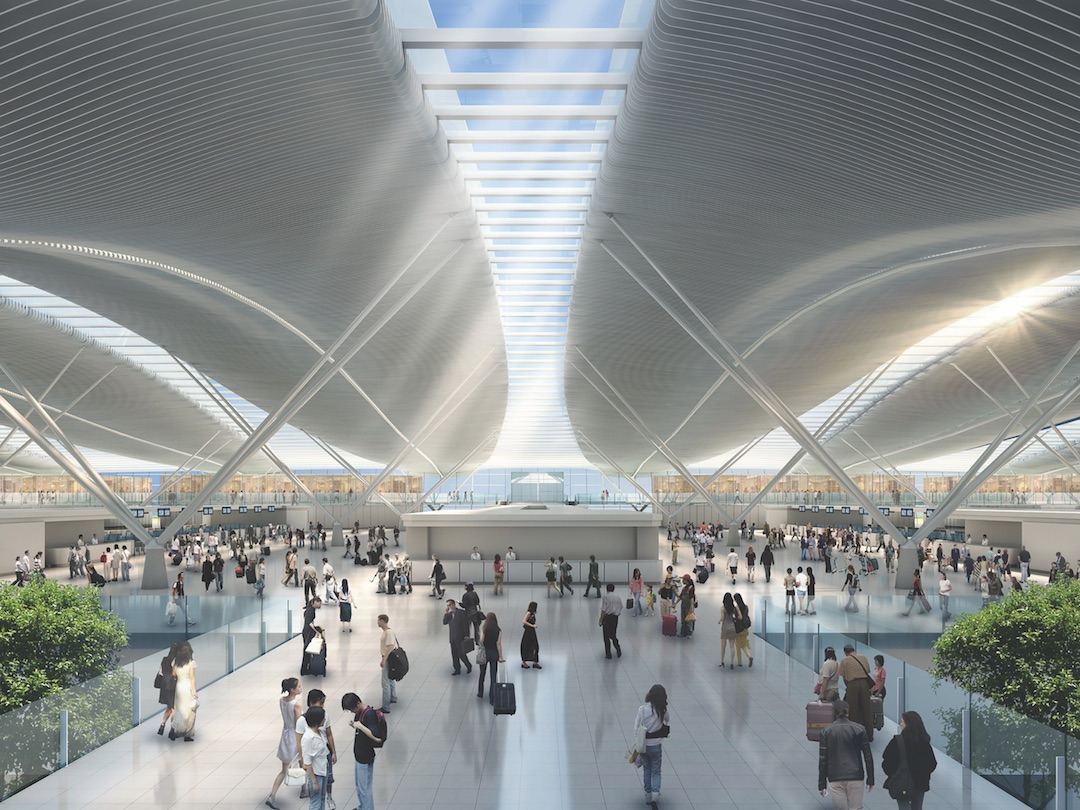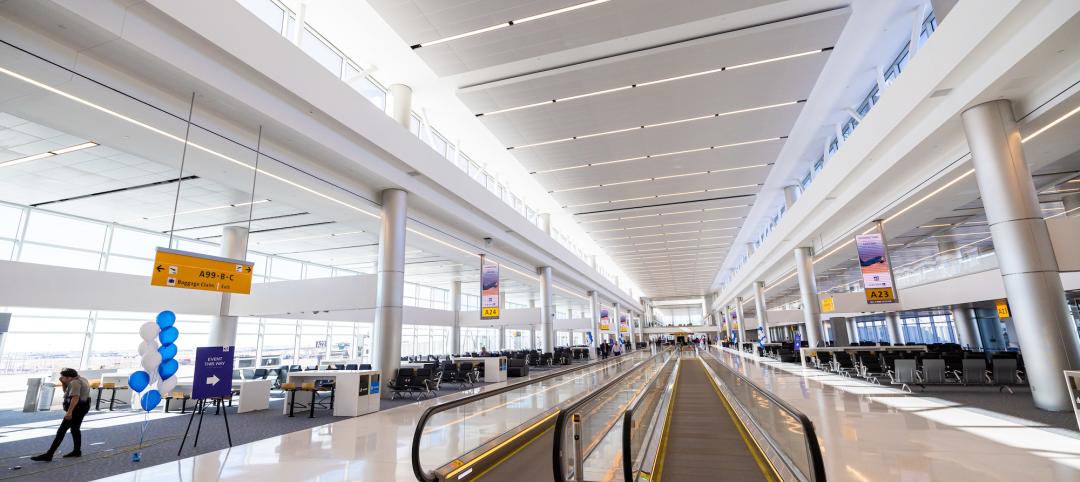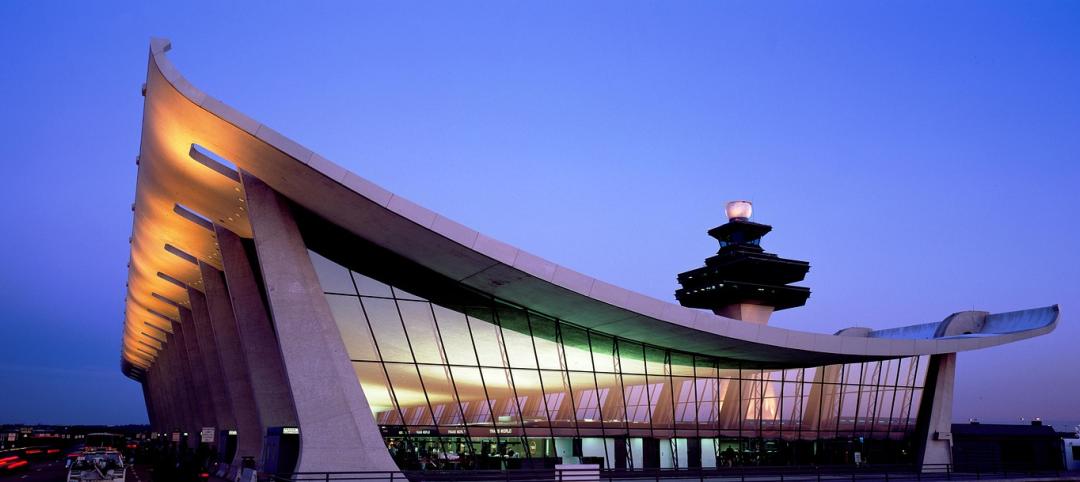Domestic and foreign airlines serving the U.S. carried an all-time high of 965 million passengers in 2017, according to the U.S. Department of Transportation. Airports Council International estimates that 8.8 billion flyers used airports worldwide last year, up 6.6%.
Airport operators everywhere are scrambling to keep pace. “Construction and expansion of airports is growing at a rate of 5–10% or more around the world,” says Jay Fraser, Vice President/General Manager of Turner Construction’s Aviation Group. Turner is adding a three-level, 50,500-sm international port at Cam Ranh International Terminal in Vietnam to handle 2.5 million passengers a year.
Turner and PLC Construction Services are working on the Federal Inspection Services (FIS) Relocation and Expansion project at San Diego International Airport’s Terminal 2 West, which will house Customs and Border Protection services.
U.S. AEC aviation-sector firms are benefiting from the high level of deferred investment in infrastructure, airline profitability, and the strength of the dollar, note Keith Thompson and Terence Young, Principals in Gensler’s Los Angeles office.
See also: Top 45 Airport Facilities Architecture + AE Firms - 2018 Giants 300 rankings
See also: Top 55 Airport Facilities Engineering + EA Firms - 2018 Giants 300 rankings
See also: Top 55 Airport Facilities Contractors + CM Firms - 2018 Giants 300 rankings
Skidmore, Owings & Merrill is lead designer for the new 450,000-sf International Arrivals Facility at Seattle-Tacoma International Airport. It will add eight gates for widebody aircraft and 50 more passport checkbooths and kiosks.
AEC firms that practice design-build or integrated design delivery methods and are open to public-private partnerships are in the sweet spot for airport projects. “Clients are looking at delivery models that save money and time,” says Bijan Pashanamaei, PE, Director of AECOM Global Aviation.
He notes that the design and build portions for the modernization of Phoenix Sky Harbor International Airport’s Terminal 3 were wrapped into a single contract that included DWL Architects + Planners, SmithGroupJJR, and Corgan.
AEC firms are using quicker delivery methods incorporating modular and prefabricated components. “Many clients start with the desire for modular construction," meaning offsite assembly to minimize on-site disruption to ongoing operations, says SOM Director Derek Moore. “This makes sense at very busy airports with little elbow room for traditional construction.”
Mortenson Construction used “substantial fabrication” to deliver an Alternate Utility Facility to support Port of Seattle’s SeaTac airport in the case of disruptive high-wind events, says Mark Baughmam, DBIA, LEED AP, a Construction Executive with Mortenson.
using technology to ease travel anxiety
Turner's Jay Fraser calls technology “the most critical design advancement” for airports. At the FIS facility in San Diego, interactive wayfinding displays and self-boarding gates that
enable planes to load without attendants are being installed.
One new feature at airport gates is a “hearing loop,” which wirelessly transmits boarding announcements to hearing-impaired passengers via their hearing aids or cochlear implants.
“The expectation of technology continues to grow project to project,” says Michael C. Braun, AIA, LEED AP, Executive Vice President with DWL. “Almost every seat has access to power, and the Wi-Fi has excellent coverage. The design must integrate these components in a way that allows them to operate without undermining the architectural features.”
shopping malls with planes
Airports are also revving up their retail and food services. “Unlike struggling malls, airports have a constant source of potential shoppers,” says Kelsey Chesney, Vice President and Senior Brand Strategist, FRCH Design Worldwide.
The design of travel retail has been shifting from a purely efficient, commodity-based model to a targeted, experienced-based one, says Kevin Horn, LEED GA, CallisonRTKL’s Vice President. Airport store designs are showcasing unique local merchandise. “Shop-in-shop” layouts highlight brands and allow flyers to engage products physically and digitally.
Horn notes that some travelers actually route their trips through two of his firm’s recent projects—Inchon International Airport in South Korea and Changi International in Singapore—to take advantage of their expansive retail offerings.
Airports, says Chesney, are becoming “self-contained cities” and homes away from home for frequent flyers. Fitness and wellness centers are popping up in airports. SOM’s Moore is seeing children’s play areas, ubiquitous electrical outlets, premium lounges, and short-term sleeping rooms.
See Also: Retail's age of experimentation
“Adding seasonal outdoor spaces post security, interior landscaping and water features, and commissioned works of art are fast developing as distinguishing features of terminal design to create a sense of place,” says Moore.
In some of its recent airport projects, Gensler has introduced a town square concept that offers spaces for concerts, fashion shows, dance presentations, and local artists’ exhibits, along with meditation and yoga rooms.
This “sense of place” extends to how an airport building is positioned vis-à-vis its outdoor surroundings. DWL’s design for Scottsdale (Ariz.) Airport’s new 23,898-sf Aviation Business Center, says Braun, integrates shaded glass façades to enhance visitors' views of the nearby McDowell Mountains.
This $27 million Terminal Area Redevelopment project, which will expand two hangars, is transforming Scottsdale Airport from a corporate, general aviation reliever facility into "a community resource and a point of pride for the city,” says Braun.
Related Stories
Architects | Apr 6, 2023
Design for belonging: An introduction to inclusive design
The foundation of modern, formalized inclusive design can be traced back to the Americans with Disabilities Act (ADA) in 1990. The movement has developed beyond the simple rules outlined by ADA regulations resulting in features like mothers’ rooms, prayer rooms, and inclusive restrooms.
Airports | Feb 28, 2023
Data visualization: $1 billion earmarked for 2023 airport construction projects
Ninety-nine airports across 47 states and two territories are set to share nearly $1 billion in funding in 2023 from the Federal Aviation Administration. The funding is aimed at help airports of all sizes meet growing air travel demand, with upgrades like larger security checkpoints and more reliable and faster baggage systems.
Intelligent Lighting | Feb 13, 2023
Exploring intelligent lighting usage in healthcare, commercial facilities
SSR's Todd Herrmann, PE, LEEP AP, explains intelligent lighting's potential use cases in healthcare facilities and more.
Giants 400 | Feb 9, 2023
New Giants 400 download: Get the complete at-a-glance 2022 Giants 400 rankings in Excel
See how your architecture, engineering, or construction firm stacks up against the nation's AEC Giants. For more than 45 years, the editors of Building Design+Construction have surveyed the largest AEC firms in the U.S./Canada to create the annual Giants 400 report. This year, a record 519 firms participated in the Giants 400 report. The final report includes 137 rankings across 25 building sectors and specialty categories.
Giants 400 | Feb 6, 2023
2022 Reconstruction Sector Giants: Top architecture, engineering, and construction firms in the U.S. building reconstruction and renovation sector
Gensler, Stantec, IPS, Alfa Tech, STO Building Group, and Turner Construction top BD+C's rankings of the nation's largest reconstruction sector architecture, engineering, and construction firms, as reported in the 2022 Giants 400 Report.
Cladding and Facade Systems | Dec 20, 2022
Acoustic design considerations at the building envelope
Acentech's Ben Markham identifies the primary concerns with acoustic performance at the building envelope and offers proven solutions for mitigating acoustic issues.
Digital Twin | Nov 21, 2022
An inside look at the airport industry's plan to develop a digital twin guidebook
Zoë Fisher, AIA explores how design strategies are changing the way we deliver and design projects in the post-pandemic world.
Giants 400 | Nov 14, 2022
Top 65 Airport Terminal Engineering + EA Firms for 2022
AECOM, Jacobs, Arup, and Burns & McDonnell head the ranking of the nation's largest airport terminal engineering and engineering/architecture (EA) firms for 2022, as reported in Building Design+Construction's 2022 Giants 400 Report.
Giants 400 | Nov 14, 2022
Top 60 Airport Terminal Contractors + CM Firms for 2022
Hensel Phelps, Turner Construction, Walsh Group, and Holder Construction top the ranking of the nation's largest airport terminal contractors and construction management (CM) firms for 2022, as reported in Building Design+Construction's 2022 Giants 400 Report.
Giants 400 | Nov 14, 2022
Top 55 Airport Terminal Architecture + AE Firms for 2022
Gensler, PGAL, Corgan, and HOK top the ranking of the nation's largest airport terminal architecture and architecture/engineering (AE) firms for 2022, as reported in Building Design+Construction's 2022 Giants 400 Report.

















